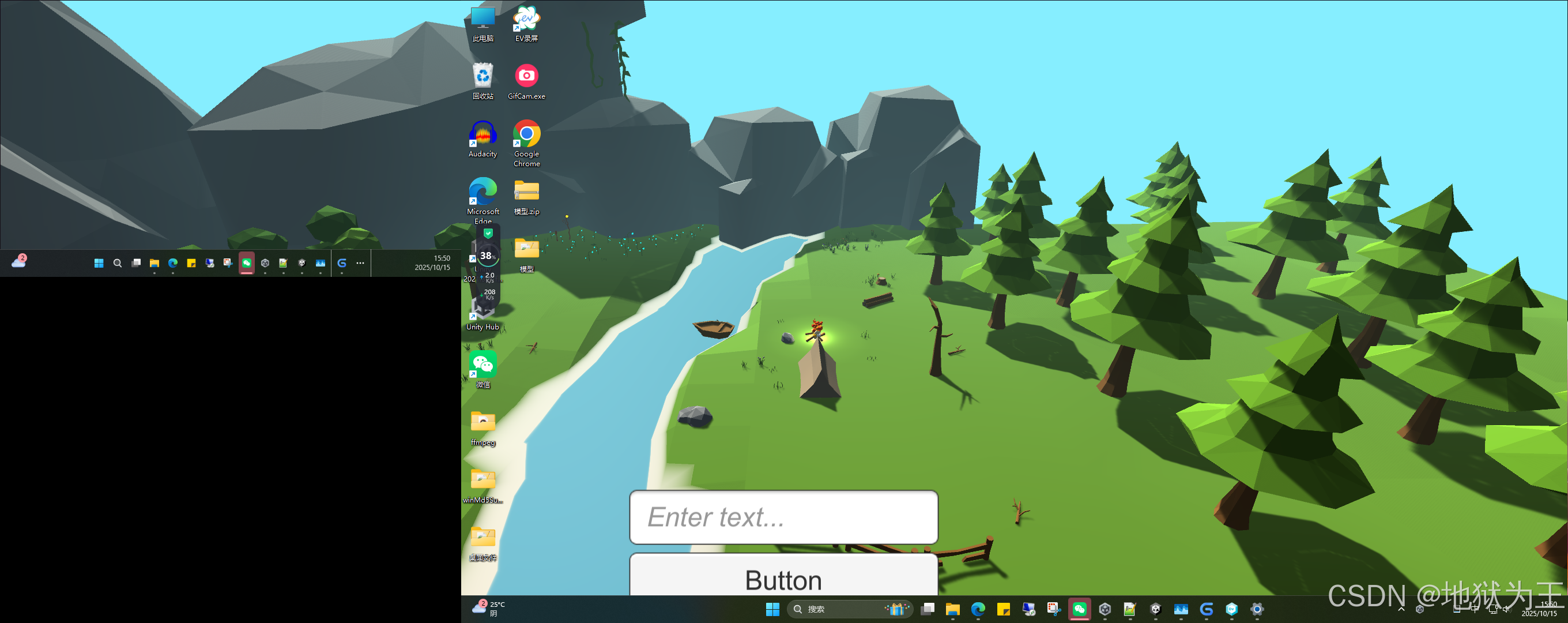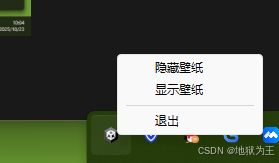先放出效果图(因为左边是个小屏幕,所以左下角是黑的)



下面是主要代码
using AOT;
using System;
using System.Runtime.InteropServices;
using System.Text;
using UnityEngine;
using UnityEngine.UI;
using Application = UnityEngine.Application;
public class WallpaperController : MonoBehaviour
{
// ====================================================================================
// 2. 常量定义
// ====================================================================================
// 窗口样式常量
const int GWL_EXSTYLE = -20;
const int WS_EX_LAYERED = 0x00080000; // 分层窗口
const int WS_EX_NOACTIVATE = 0x08000000; // 不激活窗口,不接受焦点
const uint LWA_ALPHA = 0x2; // 设置透明度
const int GWL_STYLE = -16;
const int WS_POPUP = 8388608;
// Z-Order 常量
static readonly IntPtr HWND_TOP = new IntPtr(0);
static readonly IntPtr HWND_BOTTOM = new IntPtr(1);
// SetWindowPos 标志
const uint SWP_NOMOVE = 0x0002;
const uint SWP_NOSIZE = 0x0001;
const uint SWP_NOZORDER = 0x0004;
const uint SWP_NOACTIVATE = 0x0010;
// ShowWindow 常量
const int SW_SHOW = 5; // 显示窗口
// 内部状态
private IntPtr unityWindow = IntPtr.Zero;
private static IntPtr foundWorkerW = IntPtr.Zero;
private static IntPtr foundDefView = IntPtr.Zero; // 桌面图标容器
// 新增:用于保持对象引用的 GCHandle
private GCHandle gcHandle;
// 新增:静态委托,符合 EnumChildProc 签名
private static User32.EnumChildProc staticEnumChildProc = StaticEnumChildWindowsCallback;
private static User32.EnumChildProc staticEnumChildProc2 = StaticEnumWorkerWCallback;
// ====================================================================================
// 3. Unity Start 方法 (核心逻辑)
// ====================================================================================
int width = 2720;
int height = 1080;
public Text text;
private NotifyIconItem m_NotifyIconItem;
void Start()
{
m_NotifyIconItem = new NotifyIconItem();
m_NotifyIconItem.Init();
WinScreenInfo.GetVirtualScreenSize(out width, out height);
UnityEngine.Screen.SetResolution(width, height, false);
Application.targetFrameRate = 25;
// 1. 获取 Unity 窗口句柄
unityWindow = User32.GetActiveWindow();
Invoke("SetWallPaper", 0.1f);
}
void SetWallPaper()
{
#if UNITY_STANDALONE_WIN
if (unityWindow == IntPtr.Zero)
{
Debug.LogError("无法获取 Unity 窗口句柄");
return;
}
// 临时隐藏窗口,避免闪烁
User32.ShowWindow(unityWindow, 0);
IntPtr progman = User32.FindWindow("Progman", null);
if (progman == IntPtr.Zero)
{
Debug.LogError("未找到 Progman");
return;
}
// 2. 发送消息激活 WorkerW(生成或显示用于放置背景的 WorkerW 窗口)
// 0x052C 是 WM_SPAWN_WORKERW 消息
User32.SendMessageTimeout(progman, 0x052C, IntPtr.Zero, IntPtr.Zero, 0, 1000, out _);
// 3. 遍历 Progman 的子窗口,寻找 WorkerW (真正的壁纸容器)
foundWorkerW = IntPtr.Zero;
User32.EnumChildWindows(progman, staticEnumChildProc2, IntPtr.Zero);
IntPtr parentWindow = foundWorkerW != IntPtr.Zero ? foundWorkerW : progman;
if (foundWorkerW == IntPtr.Zero)
{
Debug.LogWarning("未找到 WorkerW,回退使用 Progman 作为父窗口。");
}
else
{
Debug.Log("✅ 找到 WorkerW 作为父窗口。");
}
// 4. 设置窗口样式:分层 + 不激活
// WS_EX_NOACTIVATE 确保 Unity 窗口不会抢夺焦点,这是避免 Z-order 混乱的关键。
int exStyle = User32.GetWindowLong(unityWindow, GWL_EXSTYLE); //| WS_EX_LAYERED | WS_EX_NOACTIVATE
User32.SetWindowLong(unityWindow, GWL_EXSTYLE, exStyle);
int style = User32.GetWindowLong(unityWindow, GWL_STYLE);
User32.SetWindowLong(unityWindow, GWL_STYLE, WS_POPUP);
// 必须设为不透明 (255),否则可能导致图标背景变成黑色或透明
User32.SetLayeredWindowAttributes(unityWindow, 0, 255, LWA_ALPHA);
// 5. 将 Unity 窗口嵌入到 WorkerW/Progman 中
User32.SetParent(unityWindow, parentWindow);
// 6. 设置 Unity 窗口大小和 Z-Order
// 将 Unity 窗口置于 WorkerW 子窗口的 **最底层 (HWND_BOTTOM)**
// 这样可以确保它在桌面图标(SHELLDLL_DefView)之下。
User32.SetWindowPos(unityWindow, HWND_BOTTOM, 0, 0, width, height, SWP_NOACTIVATE);
// 7. 查找 SHELLDLL_DefView(桌面图标容器)
// 这一步现在是可选的,因为我们依赖 SetParent/HWND_BOTTOM 的组合。
// 保留此步用于日志和备用 Z-order 提升。
// 尝试在 Progman 的所有子窗口中查找 DefView
foundDefView = IntPtr.Zero;
User32.EnumChildWindows(progman, staticEnumChildProc, IntPtr.Zero);
// 8. 强制桌面图标回到顶层 (备用步骤,可能需要也可能不需要)
if (foundDefView != IntPtr.Zero)
{
// 将 DefView 窗口提升到最顶层(不改变位置和大小,不激活)
// 在第 6 步使用 HWND_BOTTOM 成功后,这一步可能不再需要。
// 但如果图标仍被覆盖,取消注释这一行。
// SetWindowPos(foundDefView, HWND_TOP, 0, 0, 0, 0, SWP_NOMOVE | SWP_NOSIZE | SWP_NOACTIVATE);
User32.ShowWindow(foundDefView, SW_SHOW);
Debug.Log("✅ 桌面图标容器已处理。");
}
else
{
Debug.LogError("❌ 未找到 SHELLDLL_DefView,图标可能被遮挡。");
}
// 9. 显示 Unity 壁纸
User32.ShowWindow(unityWindow, SW_SHOW);
// 10. 转移焦点(防止 Unity 窗口激活破坏 Z-order)
IntPtr tray = User32.FindWindow("Shell_TrayWnd", null);
if (tray != IntPtr.Zero)
{
// 再次确保任务栏可见,触发焦点转移
User32.ShowWindow(tray, SW_SHOW);
}
#endif
}
bool focus = false;
private void FixedUpdate()
{
text.text = "焦点:" + focus;
if (!focus)
{
User32.SetFocus(unityWindow);
}
//text.text = "鼠标位置:" + Input.mousePosition;
if (Input.GetMouseButton(0))
{
text.text = "鼠标点击";
}
}
private void OnApplicationFocus(bool focus)
{
this.focus = focus;
}
private void OnDestroy()
{
m_NotifyIconItem.Dispose();
}
[MonoPInvokeCallback(typeof(User32.EnumChildProc))]
private static bool StaticEnumWorkerWCallback(IntPtr hwnd, IntPtr lParam)
{
var className = new StringBuilder(256);
User32.GetClassName(hwnd, className, className.Capacity);
// 找到 WorkerW 窗口
if (className.ToString() == "WorkerW")
{
// 记录找到的 WorkerW,继续查找以确保找到最新的 WorkerW
foundWorkerW = hwnd;
}
return true;
}
[MonoPInvokeCallback(typeof(User32.EnumChildProc))]
private static bool StaticEnumChildWindowsCallback(IntPtr hwnd, IntPtr lParam)
{
var className = new StringBuilder(256);
User32.GetClassName(hwnd, className, className.Capacity);
if (className.ToString() == "SHELLDLL_DefView")
{
foundDefView = hwnd;
return false; // 找到即停
}
return true;
}
}
最初使用 System.Windows.Forms.dll 做托盘,但是不支持IL2CPP打包,最后使用了 @WangShade https://blog.csdn.net/sinat_25415095/article/details/121176468 的方案实现






















 954
954

 被折叠的 条评论
为什么被折叠?
被折叠的 条评论
为什么被折叠?










